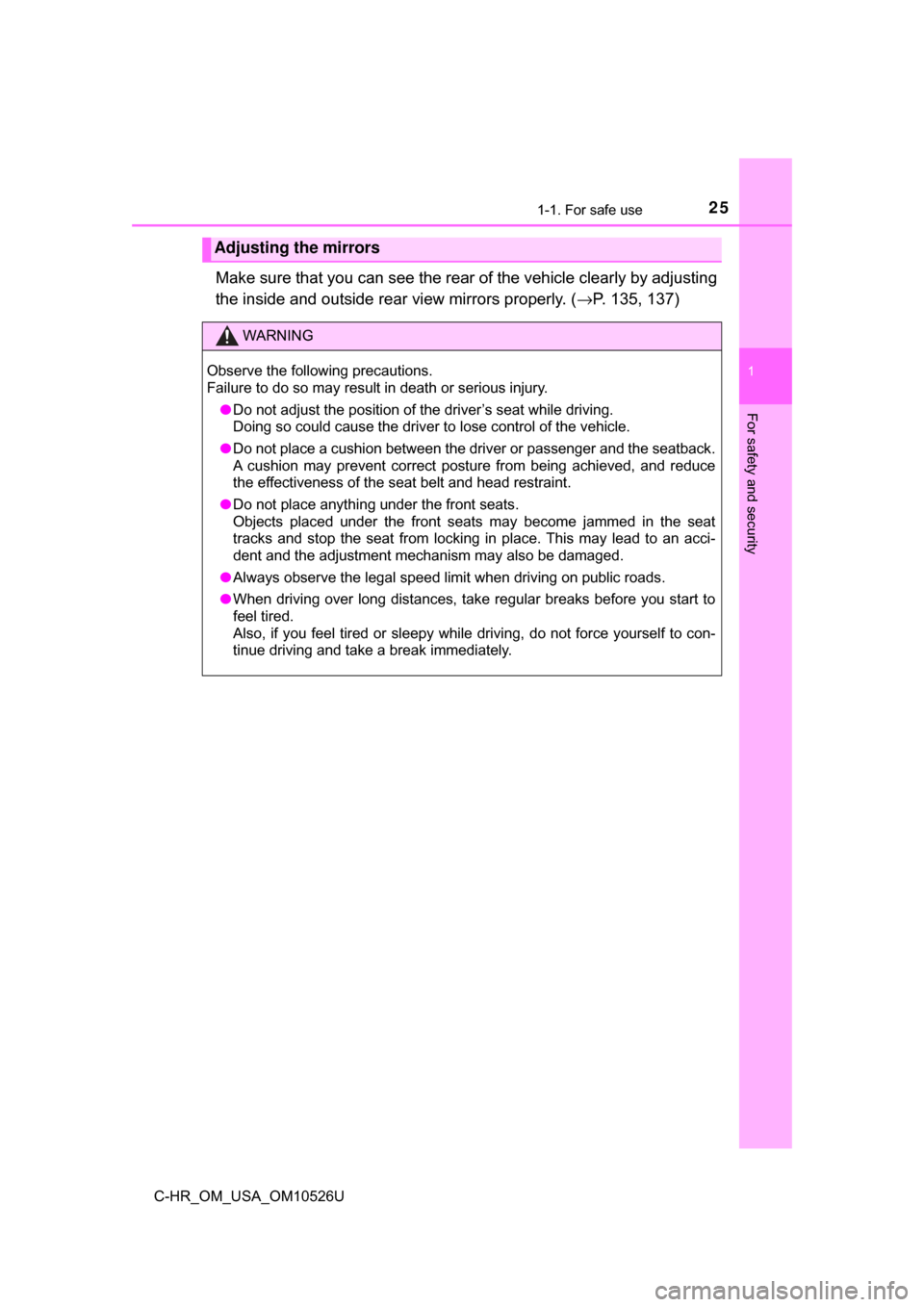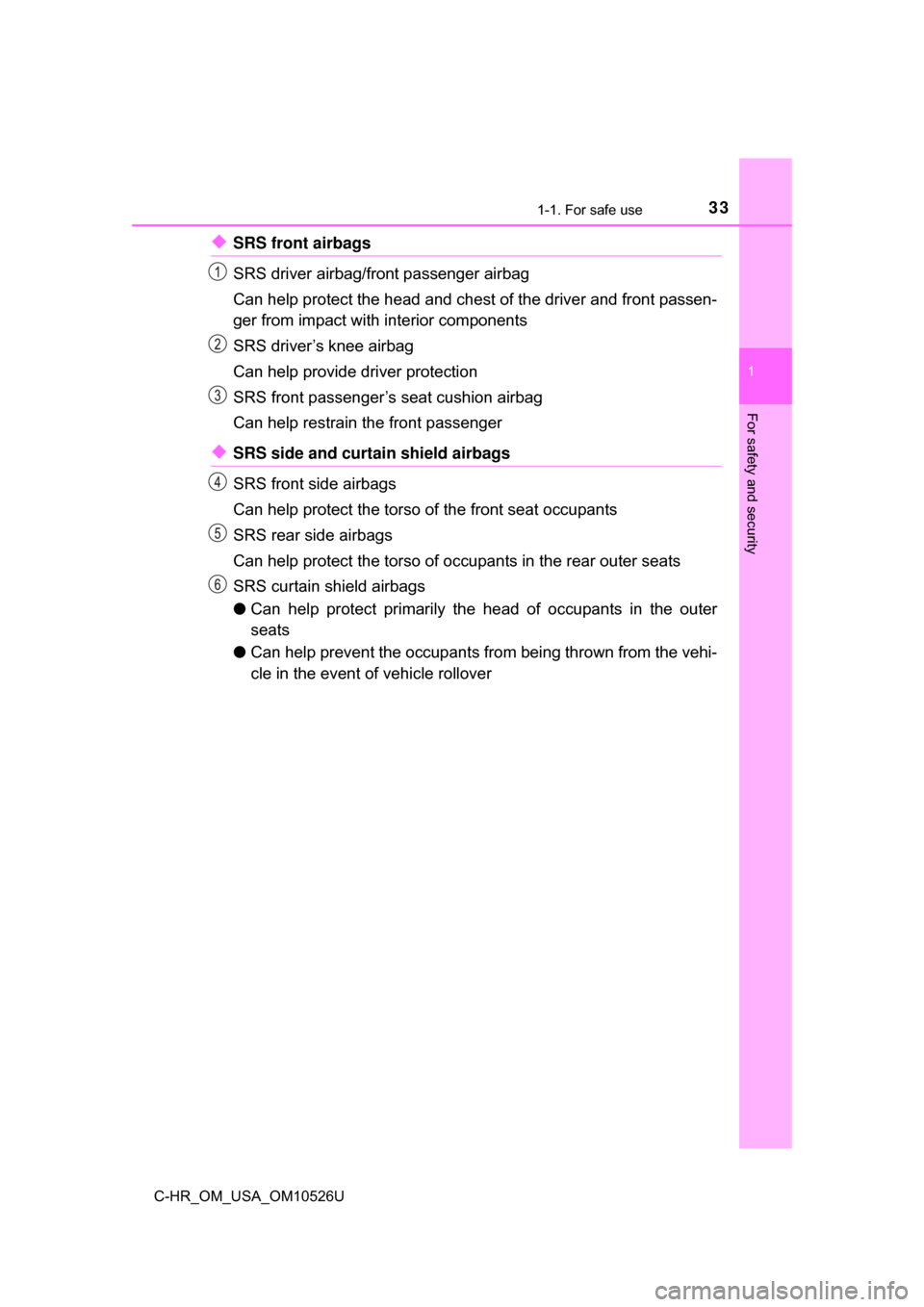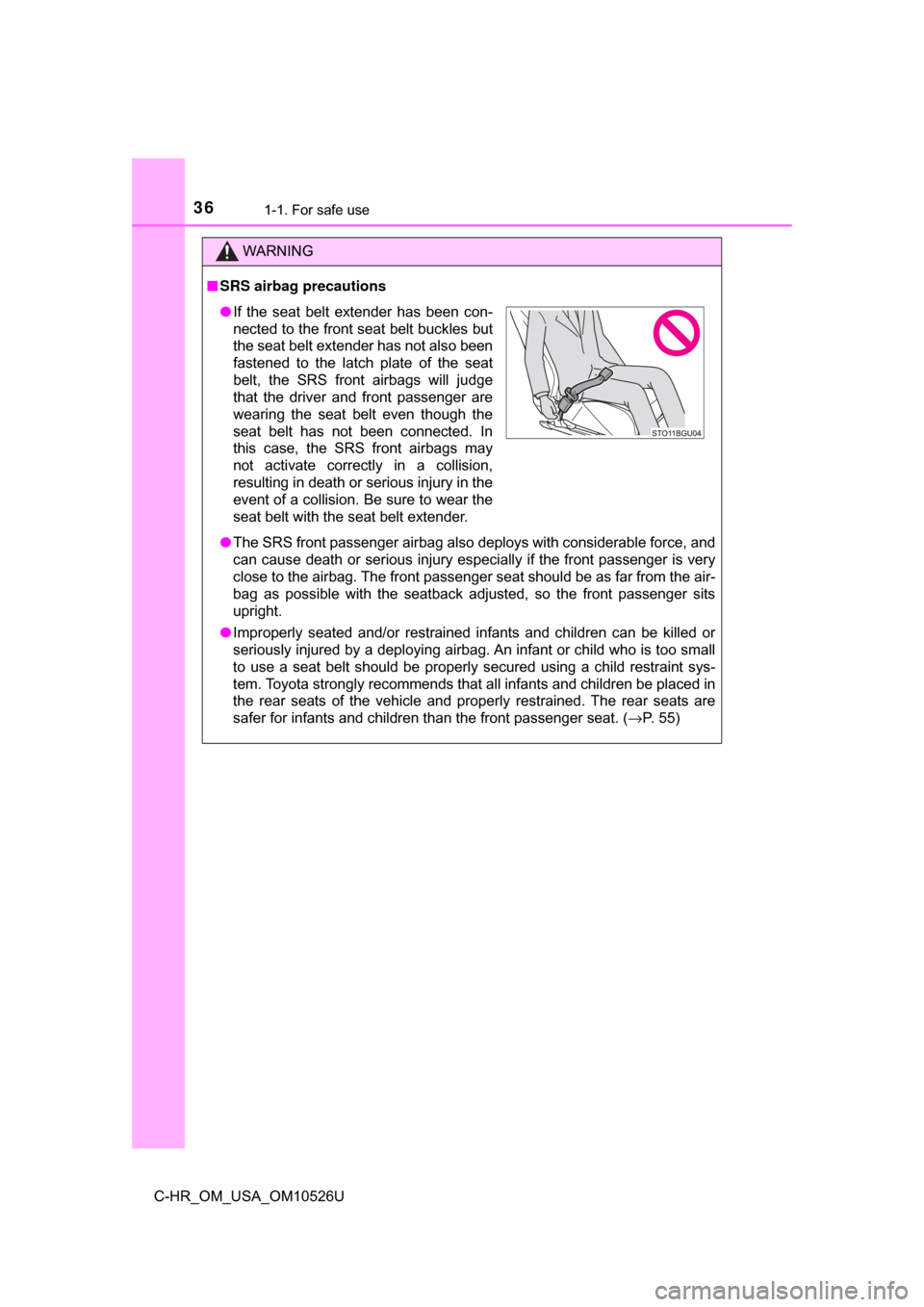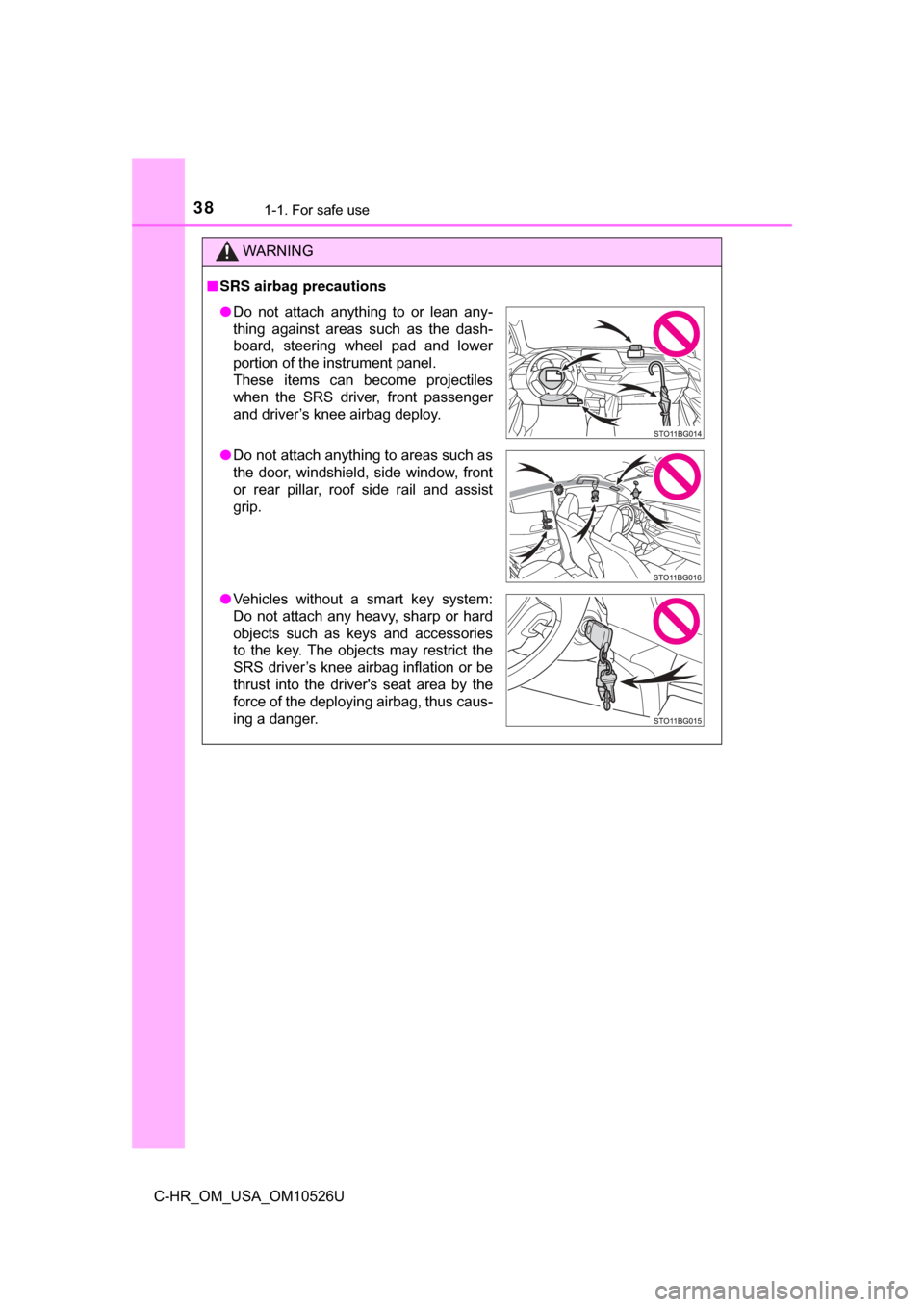passenger front seat TOYOTA C-HR 2018 1.G Owners Manual
[x] Cancel search | Manufacturer: TOYOTA, Model Year: 2018, Model line: C-HR, Model: TOYOTA C-HR 2018 1.GPages: 516, PDF Size: 9.32 MB
Page 2 of 516

TABLE OF CONTENTS2
C-HR_OM_USA_OM10526UFor your information....................... 6
Reading this manual .................... 10
How to search .............................. 11
Pictorial index .............................. 12
1-1. For safe use
Before driving ...................... 22
For safety drive ................... 24
Seat belts ............................ 26
SRS airbags ........................ 32
Front passenger occupant classification system ......... 46
Exhaust gas precautions ..... 53
1-2. Child safety Riding with children ............. 54
Child restraint systems ........ 55
1-3. Theft deterrent system Engine immobilizer system............................... 74
Theft prevention labels (U.S.A.) ............................. 76
2. Instrument cluster Warning lights and indicators........................... 78
Gauges and meters............. 86
Multi-information display ..... 89 3-1. Key information
Keys..................................... 98
3-2. Opening, closing and locking the doors
Side doors ......................... 105
Back door .......................... 112
Smart key system .............. 118
3-3. Adjusting the seats Front seats......................... 127
Rear seats ......................... 128
Head restraints .................. 130
3-4. Adjusting the steering wheel and mirrors
Steering wheel ................... 133
Inside rear view mirror ....... 135
Outside rear view mirrors ............................. 137
3-5. Opening and closing the windows
Power windows.................. 140
1For safety and security
2Instrument cluster
3Operation of each
component
Page 21 of 516

21
For safety and security1
C-HR_OM_USA_OM10526U1-1. For safe use
Before driving ...................... 22
For safety drive ................... 24
Seat belts ............................ 26
SRS airbags ........................ 32
Front passenger occupant classification system ......... 46
Exhaust gas precautions..... 53
1-2. Child safety Riding with children ............. 54
Child restraint systems........ 55
1-3. Theft deterrent system Engine immobilizer system .............................. 74
Theft prevention labels (U.S.A.) ............................. 76
Page 25 of 516

251-1. For safe use
1
For safety and security
C-HR_OM_USA_OM10526U
Make sure that you can see the rear of the vehicle clearly by adjusting
the inside and outside rear view mirrors properly. ( →P. 135, 137)
Adjusting the mirrors
WARNING
Observe the following precautions.
Failure to do so may result in death or serious injury.
● Do not adjust the position of the driver’s seat while driving.
Doing so could cause the driver to lose control of the vehicle.
● Do not place a cushion between the driver or passenger and the seatback.
A cushion may prevent correct posture from being achieved, and reduce
the effectiveness of the seat belt and head restraint.
● Do not place anything under the front seats.
Objects placed under the front seats may become jammed in the seat
tracks and stop the seat from locking in place. This may lead to an acci-
dent and the adjustment mechanism may also be damaged.
● Always observe the legal speed limit when driving on public roads.
● When driving over long distances, take regular breaks before you start to
feel tired.
Also, if you feel tired or sleepy while driving, do not force yourself to con-
tinue driving and take a break immediately.
Page 30 of 516

301-1. For safe use
C-HR_OM_USA_OM10526U
WARNING
■People suffering illness
Obtain medical advice and wear the seat belt in the proper way. ( →P. 26)
■ When children are in the vehicle
→ P. 6 6
■ Seat belt pretensioners (fro nt seats and outboard rear seats)
● Do not place anything, such as a cushion, on the front passenger's seat.
Doing so will disperse the passenger's weight, which prevents the sensor
from detecting the passenger's weight properly. As a result, the seat belt
pretensioner for the front passenger's seat may not activate in the event of
a collision.
● If the pretensioner has activated, the SRS warning light will come on. In
that case, the seat belt cannot be used again and must be replaced at
your Toyota dealer.
■ Adjustable shoulder anchor (front seats)
Always make sure the shoulder belt is positioned across the center of your
shoulder. The belt should be kept away from your neck, but not falling off
your shoulder. Failure to do so could reduce the amount of protection in an
accident and cause death or serious injuries in the event of a sudden stop,
sudden swerve or accident. ( →P. 27)
■ Seat belt damage and wear
● Do not damage the seat belts by allowing the belt, plate, or buckle to be
jammed in the door.
● Inspect the seat belt system periodically. Check for cuts, fraying, and loose
parts. Do not use a damaged seat belt until it is replaced. Damaged seat
belts cannot protect an occupant from death or serious injury.
● Ensure that the belt and plate are locked and the belt is not twisted.
If the seat belt does not function correctly, immediately contact your Toyota
dealer.
● Replace the seat assembly, including the belts, if your vehicle has been
involved in a serious accident, even if there is no obvious damage.
● Do not attempt to install, remove, modify, disassemble or dispose of the
seat belts. Have any necessary repairs carried out by your Toyota dealer.
Inappropriate handling may lead to incorrect operation.
Page 33 of 516

331-1. For safe use
1
For safety and security
C-HR_OM_USA_OM10526U
◆SRS front airbags
SRS driver airbag/front passenger airbag
Can help protect the head and chest of the driver and front passen-
ger from impact with interior components
SRS driver’s knee airbag
Can help provide driver protection
SRS front passenger’s seat cushion airbag
Can help restrain the front passenger
◆SRS side and curtain shield airbags
SRS front side airbags
Can help protect the torso of the front seat occupants
SRS rear side airbags
Can help protect the torso of occupants in the rear outer seats
SRS curtain shield airbags
● Can help protect primarily the he ad of occupants in the outer
seats
● Can help prevent the occupants from being thrown from the vehi-
cle in the event of vehicle rollover
Page 34 of 516

341-1. For safe use
C-HR_OM_USA_OM10526U
SRS airbag system components
Front impact sensors
Front passenger airbag
“AIR BAG ON” and “AIR BAG
OFF” indicator lights
Side impact sensors (front)
Side impact sensors (front
doors)
Seat belt pretensioners and
force limiters (front)
Side airbags (front)
Side airbags (rear)
Curtain shield airbags
Side impact sensors (rear)Driver’s seat position sensor
Driver airbag
Driver’s knee airbag
SRS warning light
Airbag sensor assembly
Seat belt pretensioners and
force limiters (rear)
Seat cushion airbag
Front passenger’s seat belt
buckle switch
Driver’s seat belt buckle
switch
Front passenger occupant
classification system (ECU
and sensors)
Page 36 of 516

361-1. For safe use
C-HR_OM_USA_OM10526U
WARNING
■SRS airbag precautions
● The SRS front passenger airbag also deploys with considerable force, and
can cause death or serious injury especially if the front passenger is very
close to the airbag. The front passenger seat should be as far from the air-
bag as possible with the seatback adjusted, so the front passenger sits
upright.
● Improperly seated and/or restrained infants and children can be killed or
seriously injured by a deploying airbag. An infant or child who is too small
to use a seat belt should be properly secured using a child restraint sys-
tem. Toyota strongly recommends that all infants and children be placed in
the rear seats of the vehicle and properly restrained. The rear seats are
safer for infants and children than the front passenger seat. ( →P. 55)
●If the seat belt extender has been con-
nected to the front seat belt buckles but
the seat belt extender has not also been
fastened to the latch plate of the seat
belt, the SRS front airbags will judge
that the driver and front passenger are
wearing the seat belt even though the
seat belt has not been connected. In
this case, the SRS front airbags may
not activate correctly in a collision,
resulting in death or serious injury in the
event of a collision. Be sure to wear the
seat belt with the seat belt extender.
Page 37 of 516

371-1. For safe use
1
For safety and security
C-HR_OM_USA_OM10526U
WARNING
■SRS airbag precautions
● Do not sit on the edge of the seat or
lean against the dashboard.
● Do not allow a child to stand in front of
the SRS front passenger airbag unit or
sit on the knees of a front passenger.
● Do not allow the front seat occupants to
hold items on their knees.
● Do not lean against the door, the roof
side rail or the front, side and rear pil-
lars.
● Do not allow anyone to kneel on the
passenger seats toward the door or put
their head or hands outside the vehicle.
Page 38 of 516

381-1. For safe use
C-HR_OM_USA_OM10526U
WARNING
■SRS airbag precautions
● Do not attach anything to or lean any-
thing against areas such as the dash-
board, steering wheel pad and lower
portion of the instrument panel.
These items can become projectiles
when the SRS driver, front passenger
and driver’s knee airbag deploy.
● Do not attach anything to areas such as
the door, windshield, side window, front
or rear pillar, roof side rail and assist
grip.
● Vehicles without a smart key system:
Do not attach any heavy, sharp or hard
objects such as keys and accessories
to the key. The objects may restrict the
SRS driver’s knee airbag inflation or be
thrust into the driver's seat area by the
force of the deploying airbag, thus caus-
ing a danger.
Page 39 of 516

391-1. For safe use
1
For safety and security
C-HR_OM_USA_OM10526U
WARNING
■SRS airbag precautions
● If a vinyl cover is put on the area where the SRS driver’s knee airbag will
deploy, be sure to remove it.
● Do not use seat accessories which cover the parts where the SRS side
airbags and SRS seat cushion airbag inflate as they may interfere with
inflation of the SRS airbags. Such accessories may prevent the side air-
bags and seat cushion airbag from activating correctly, disable the system
or cause the side airbags and seat cushion airbag to inflate accidentally,
resulting in death or serious injury.
● Do not strike or apply significant levels of force to the area of the SRS air-
bag components or the front doors.
Doing so can cause the SRS airbags to malfunction.
● Do not touch any of the component parts immediately after the SRS air-
bags have deployed (inflated) as they may be hot.
● If breathing becomes difficult after the SRS airbags have deployed, open a
door or window to allow fresh air in, or leave the vehicle if it is safe to do
so. Wash off any residue as soon as possible to prevent skin irritation.
● If the areas where the SRS airbags are stored, such as the steering wheel
pad and front and rear pillars garnishes, are damaged or cracked, have
them replaced by your Toyota dealer.
● Do not place anything, such as a cushion, on the front passenger's seat.
Doing so will disperse the passenger's weight, which prevents the sensor
from detecting the passenger's weight properly. As a result, the SRS front
airbags for the front passenger may not deploy in the event of a collisi\
on.